Part of a series of articles titled From Backcountry to Breadbasket to Battlefield and Beyond.
Previous: Faces of the Valley
Article
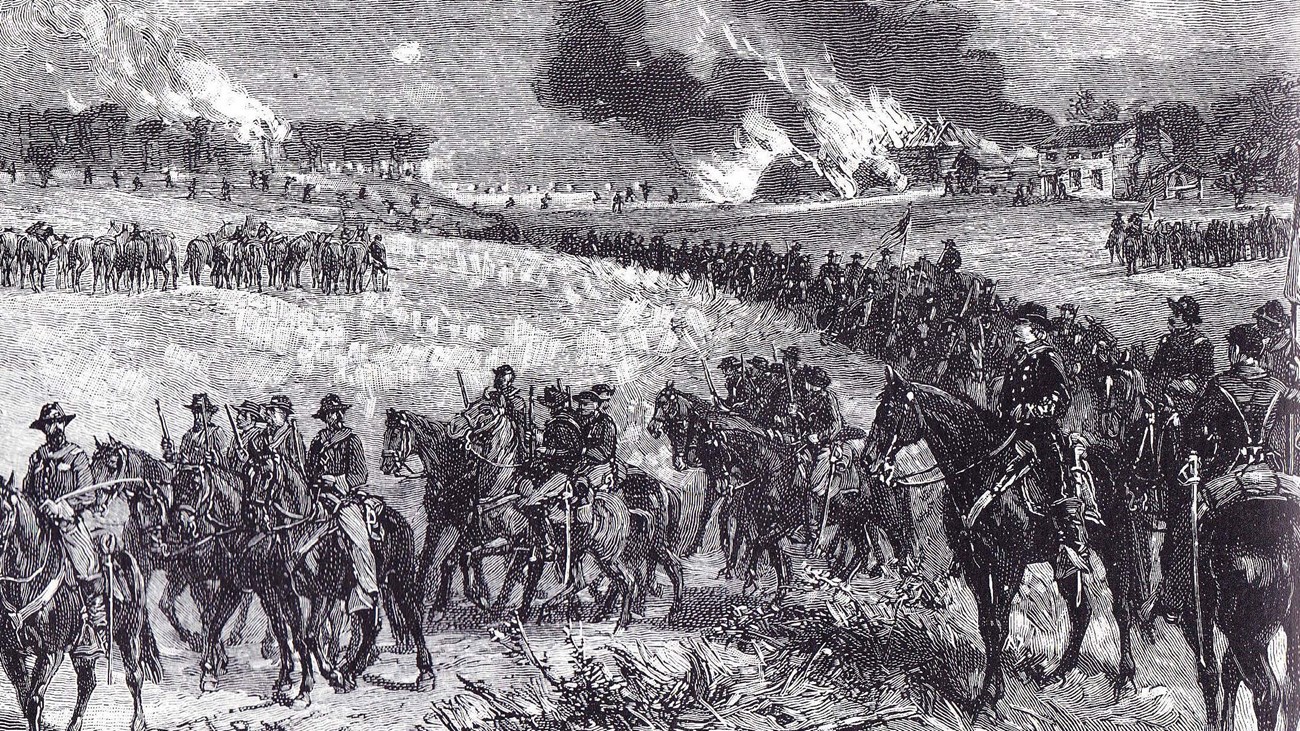
"Voices from a War Torn Valley" is a flip book of illustrations, quotations, and stories from the exhibit "From Backcountry to Breadbasket, to Battlefield, and Beyond."
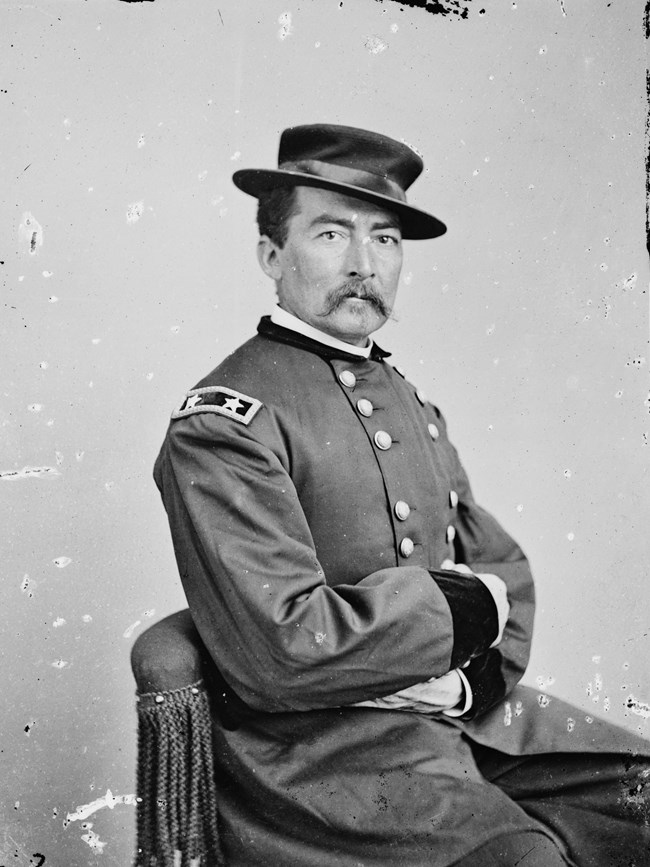
Library of Congress
“Those who rest at home in peace and plenty see but little of the horrors [of war] and even grow indifferent to them as the struggle goes on, contenting themselves with encouraging all who are able-bodied to enlist in the cause… It is another matter, however, when deprivation and suffering are brought to their own doors. Then the case appears much graver, for the loss of property weights heavy with the most of mankind; heavier often, than the sacrifices made on the field of battle.”
— General Sheridan, 1864
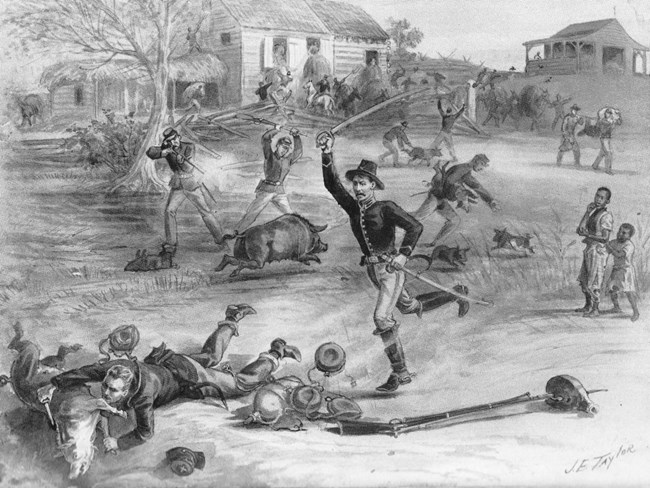
Sketch by James E. Taylor
“The whole country from the Blue Ridge to the North Mountain has been made untenable for a rebel army. I have destroyed over two thousand barns filled with wheat, hay and farming implements, and over seventy mills filled with flour and wheat, and have driven in front of his army over four thousand head of stock and have killed and issued to the troops not less than three thousand sheep. Tomorrow I will continue the destruction down to Fisher’s Mill. When this is completed, the Valley from Winchester to Staunton, 92 miles, will have but little in it for man or beast.”
— General Sheridan, Union Army
“The poor, alike with the rich, have suffered. Some have lost their all. The wailing of women and children, mingling with the crackling of flames, has sounded from scores of dwellings. I have seen mothers weeping over the loss of that which was necessary to their children’s lives, setting aside their own; their last cow, their last bit of flour pilfered by stragglers, the last morsel that they had in the world to eat or drink. Young girls with flushed cheeks, or pale with tearful or tearless eyes, have pleaded with or cursed the men whom the necessities of war have forced to burn the building reared by their fathers, and turn them into paupers in a day. The completeness of the desolation is awful.”
— Northern news correspondent traveling with Sheridan
“In the fall of this year Sheridan made his raid through the Valley destroying everything as they went. They came to our house and went all through it and took anything that was of any value to them. Some went in the hog pen and killed the hogs and took the best of the meat and left the balance lay. It was bang bang all day shooting hogs, sheep, and chickens, so that it was not safe to go out of doors…. I never will forget the evening when they burnt the buildings.”
— Samuel Blosser, Valley resident
“[My family] didn’t have anything hardly, and we had to go mighty far away to get our first meat. The fences were all gone…our only horse was a broken down army horse that was picked up on that battlefield.”
— Mary Stickley, Valley resident
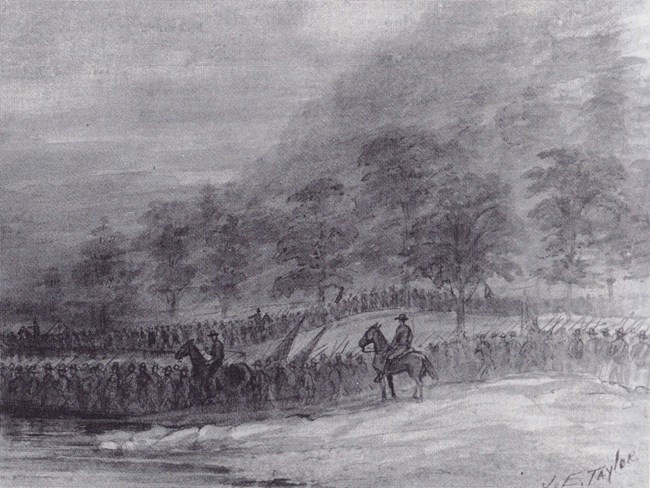
“The plan was to abandon serious attack on Sheridan’s forces where all things were in readiness…while the heavy and decisive blow should be given upon the Union left, where no preparation was made to resist us…
“This plan was finally adopted by General Early, and the movement was begun with the coming of the darkness. The men were stripped of canteens and of everything calculated to make noise and arouse Sheridan’s pickets…every man, from the commanders of the divisions to the brave privates under them, impressed with the gravity of our enterprise, speaking only when necessary and then in whispers, and striving to suppress every sound, the long gray line like a great serpent glided noiselessly along the dim pathway above the precipice…
“In the still starlit night, the only sounds heard were the gentle rustle of leaves by the October wind, the low murmur of the Shenandoah flowing swiftly along its rocky bed and dashing against the limestone cliffs that bordered it, …and the subdued tones or half-whispers of my men as they thoughtfully communed with each other as to the fate which might befall each in the next hour…
“As soon as Payne had cleared the ford for the infantry, Evans, with his Virginians, North Carolinians, and Georgians, the old Stonewall Brigade leading, rushed into the cold current of the Shenandoah, chilled as it was by the October nights and frosts. The brave fellows did not hesitate for a moment. Reaching the eastern bank drenched and cold, they were ready for the “double quick,” which warmed them up and brought them speedily to the left flank of Sheridan’s sleeping army.”
— Major General John Gordon, Confederate States Army
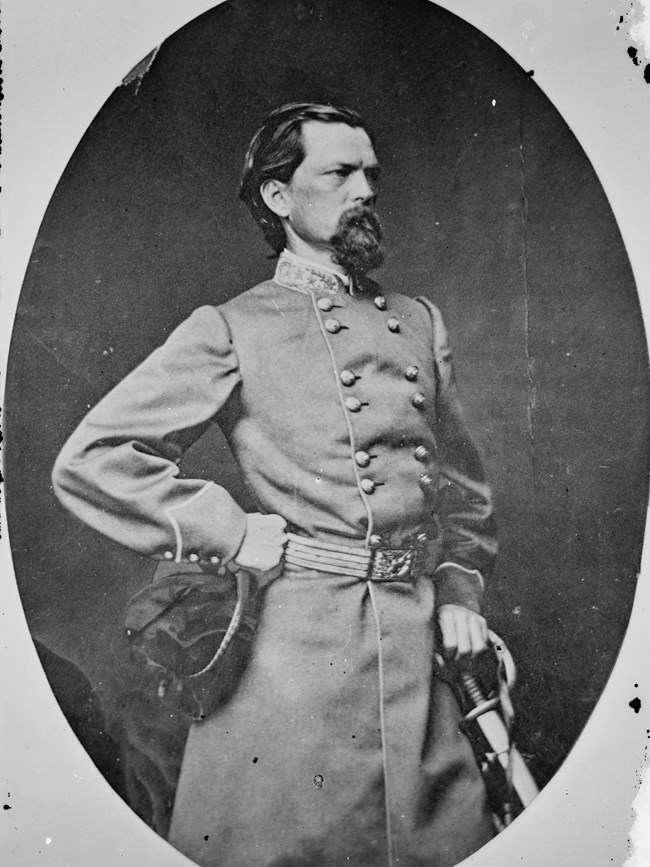
Library of Congress
“Such a sight as met our eyes as we mounted their works was not often seen. For a mile or more in every direction towards the rear was a vast plain or broken plateau, with not a tree or shrub in sight. Tents whitened the field from one end to the other…while the country behind was one living sea of men and horses—all fleeing for life and safety. Men, shoeless and hatless, went flying like mad to the rear, some with and some without their guns…caissons were going like the wind, the drivers laying the lash all the while…. Such confusion, such a panic, was never witnessed before by the troops.”
— Captain D. Augustus Dickert,3rd South Carolina
“So many of our men had stopped in the camp to plunder (in which I am sorry to say that officers participated), the country was so open, and the enemy’s cavalry so strong, that I did not deem it prudent to press further.”
— General Early writing to Robert E. Lee
“Why we did not attack at once before they got over the confusion and demoralization caused by the surprise and stampede I do not know. We had much to gain by taking the offensive, everything to lose by delay.”
— Major Henry Kyd Douglas, Confederate staff officer
“General Early insisted…that the “bad conduct” of his own men caused the astounding disaster; while I was convinced that it was due solely to the unfortunate halting and delay after the morning victory.”
— General John B. Gordon
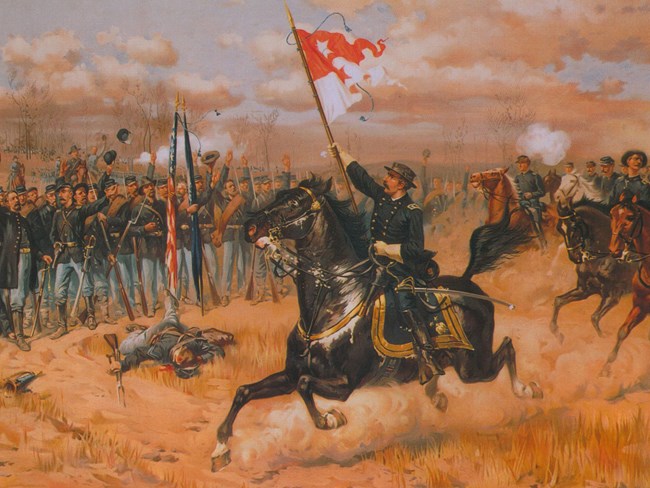
Library of Congress
“There burst upon our view the appalling spectacle of a panic-stricken army - hundreds of slightly wounded men, throngs of others unhurt but utterly demoralized, and baggage-wagons by the score, all pressing to the rear in hopeless confusion, telling only too plainly that a disaster had occurred at the front.
— General Sheridan, describing the scene that greeted him upon his return to the field around 10:00 a.m.
“I am happy to say that hundreds of the men, when on reflection found they had not done themselves justice, came back with cheers…. Still none behaved more gallantly or exhibited greater courage than those who returned from the rear determined to reoccupy their lost camp.”
— General Sheridan
“The men sprang to their feet and cheered as only men under such circumstances can… Hope and confidence returned at a bound. No longer did we merely hope that the worst was over, that we could hold our ground until night, or, at worst, make a good orderly retreat to Winchester. Now we all burned to attack the enemy, to drive him back, to retrieve our honor and sleep in our old camp that night. And every man knew that Sheridan would do it.”
— J.R. Bowen, a New York Cavalry trooper
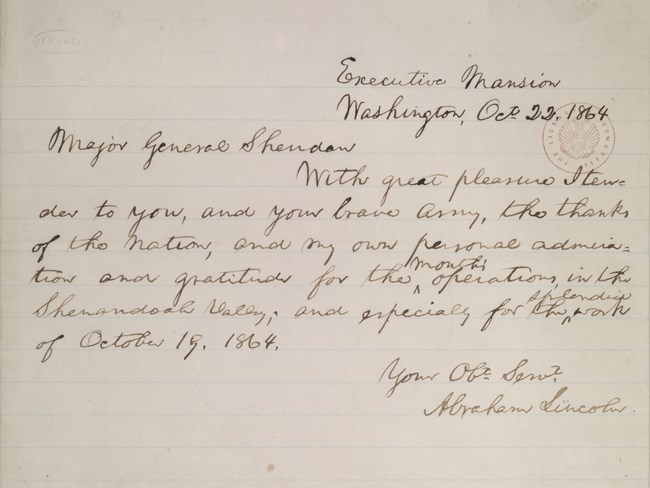
Library of Congress
“We have again been favored by a great victory - a victory won from disaster by the gallantry of our officers and men. The attack on the enemy was made about 3 p.m. by a left half-wheel of the whole line, with a division of cavalry turning each flank of the enemy, the whole line advancing. The enemy, after a stubborn resistance, broke and fled, and were pushed with vigor. The artillery captured will probably be over fifty pieces - this, of course, includes what was captured from our troops in the early morning. At least 1,600 prisoners have been brought in; also wagons and ambulances in large numbers. This morning the cavalry made a dash at Fisher’s Hill and carried it, the enemy having fled during the night.”
— General Sheridan, reporting to General Grant after the Battle of Cedar Creek
“With great pleasure I tender to you and your brave army the thanks of the nation, and my own personal admiration and gratitude for the month’s operations in the Shenandoah Valley; and especially for the splendid work of October 19, 1864.”
— Abraham Lincoln to Gen. Sheridan
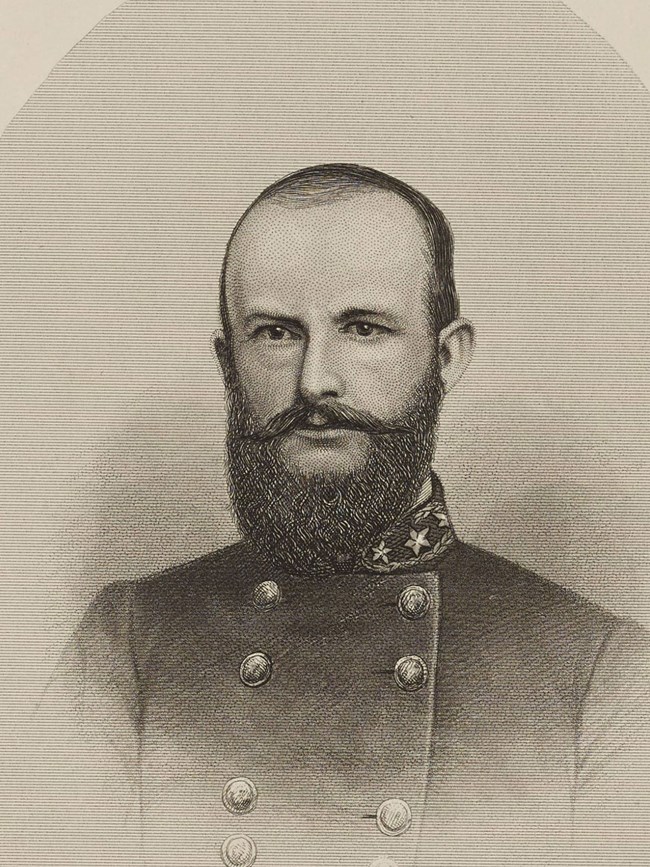
North Carolina Collection Photographic Archives, University of North Carolina at Chapel Hill
Stephen Dodson Ramseur was just 27 when he was promoted to major general, the youngest in the Confederate army. A native of North Carolina, Ramseur graduated from West Point in 1860. With the beginning of the war, he resigned his commission and joined the Confederacy, rising rapidly through the ranks. Promoted to major general on June 1, 1864 Ramseur commanded a division of approximately 3,000 men.
Ramseur married Ellen (“Nellie”) Richmond on October 28, 1863. Less than a year later, on the eve of the Battle of Cedar Creek, Ramseur learned that Nellie had safely given birth to their first child. Not knowing if the baby was a son or daughter, Ramseur hoped to gain a victory and then return home on furlough to visit his wife and child. The hope died at Cedar Creek.
Robert R. Hutchison, on Ramseur’s staff, described his commander’s fate in a letter written to Nellie the day after the battle:
“He received his mortal wound yesterday afternoon, between 5&6 p.m., at the post of honor and of danger where he always was. Our troops had fallen back a short distance, but had reformed and were stubbornly contesting a position on a hill which the enemy attacked from three sides. He exposed himself to every shot cheering and encouraging all. I was not far from him when I saw his horse shot, he procured another, which was shot also and immediately after he received his fatal wound (the second) all in a space of a very few moments. I ran over to him, got some men, and bore him the rear…[in] the ambulance I had brought up.”
During the Confederate stampede, Ramseur was captured by Union cavalry and taken to Belle Grove, where doctors soon proclaimed his wound mortal.
While on his death-bed, Ramseur was visited by several of his former West Point classmates who were now officers with the Union army; including Brig. Gen. George A. Custer, Brig. Gen. Wesley Merritt and Capt. Henry DuPont.
Fifty-six years later, on September 16, 1920, at the dedication of a monument on the Cedar Creek battlefield honoring the gallant Ramseur, Senator Henry DuPont, spoke of visiting his former classmate during his final hours at Belle Grove:
“Ramseur was at once installed in one of the most commodious bedrooms in the house and all possible steps taken…to mitigate his sufferings… The room was absolutely still. Ramseur, clad in his major general’s uniform, lay on his back in the bed his eyes closed.… Approaching the bed I said: “Ramseur, do you know me?” …he opened his eyes, in which I saw recognition and apparently a gleam of pleasure…. Speaking with the greatest effort he said to me:
‘Du Pont, you know how I suffer,’ and then relapsed into silence and closed his eyes not, however, before extending his hand and firmly grasping and holding mine. I was deeply moved. Strange as it may seem—illogical, if you please—in that supreme moment he turned with content and satisfaction to the one person present who officially a foe, was still, as he instinctively felt, the steadfast personal friend of former days!”
Ramseur died the next day, thus leaving Nellie a widow, and his new daughter, Mary Ramseur, fatherless. Stephen Dodson Ramseur represents just one of over 620,000 thousand Americans who died during the war, and the impact their loss had on those at home.
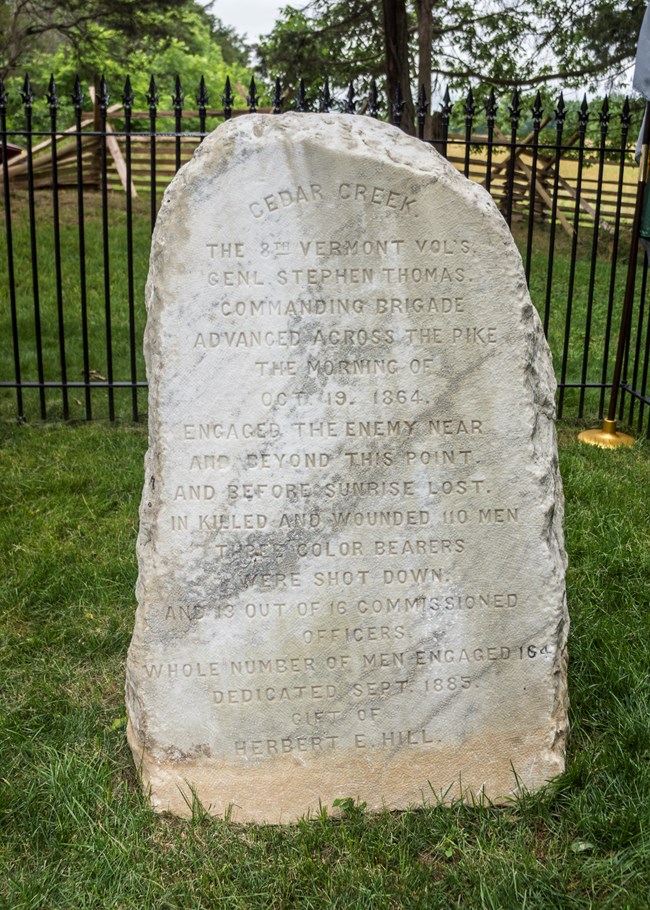
NPS
“Mother went to the battlefield to care for the wounded and said it was the worst sight she ever saw, men, and mules and horses lay thick on the ground.”
— Annie Shull, Valley resident
Annie Shull even believed that some of the Union soldiers she encountered had actually taken property from her prior to the battle. Shull remembered, “she saw some that robbed us… before, and did all she could for all, not many rebels among them.”
"Mercy abandons the arena of battle, but when the conflict is ended mercy again asserts itself.”
— Un-named soldier
Captain S. E. Howard, 8th Vermont, at the dedication of his regiment’s monument in 1885:
“Placed here, not for glorification, but to mark the spot where our comrades fell, to mark the place of an important public event, and a turning-point in a nation’s history, let it also have a deeper meaning to us of the North, and you, our brothers of the South. Let it be a pillar of stone which shall forever mark an era of genuine fraternal feeling between us.”
Part of a series of articles titled From Backcountry to Breadbasket to Battlefield and Beyond.
Previous: Faces of the Valley
Last updated: November 21, 2023